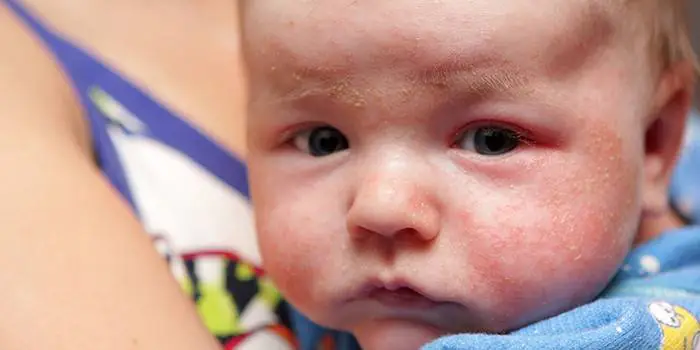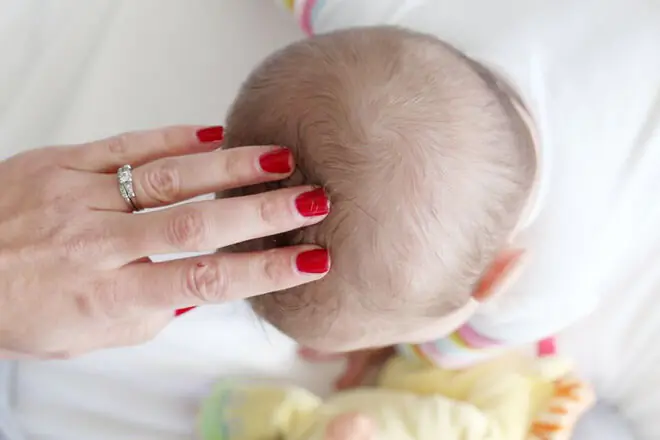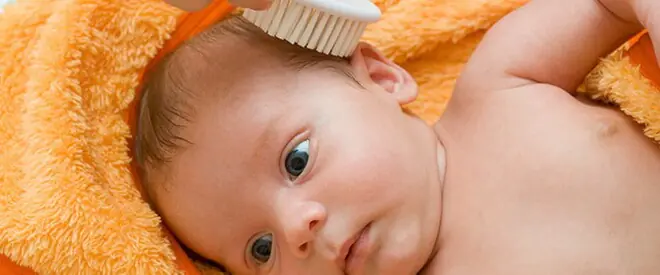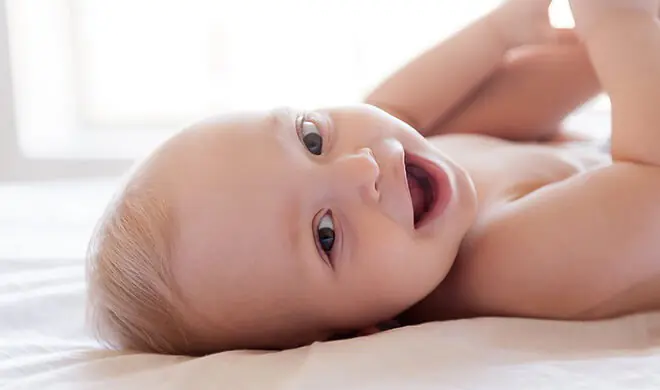Infants often experience problems with the skin - redness, inflammation, allergic reactions. If a newborn's skin is peeling, it needs to be moisturized using special products; this problem can occur in a child for various reasons. Peeling in a baby may appear as a reaction to a new environment, dry air, or clothing made from artificial fabrics.
What is peeling skin in a newborn?
Sometimes this type of irritation can be confused with other more or less dangerous diseases, so you need to know what peeling looks like. If your skin is flaking, you may notice the formation of small dead white skin particles in areas of dryness. At the edges they may have a yellow tint and a compacted structure and vary in size. For example, flaking caused by extreme dry air resembles dandruff, and particles fall off when touched.
The scales can be removed with a comb or a damp cloth, but to prevent them from appearing again, it is necessary to eliminate their cause - excessive dryness of the skin due to external irritants. Sometimes, at the places where these scales form, you can notice small wounds that can leave traces of blood. This suggests that the baby was combing them. Peeling can occur on any part of a child's skin.

Symptoms
If the skin of a newborn is peeling, this is determined by the following external signs:
- odorless white or yellow crusts form;
- the baby behaves anxiously because the peeling causes itching;
- in the initial stages, when the scales are very small or there are few of them, particles similar to dandruff can be found in the baby’s crib.
If the cause is an adaptation period, peeling lasts about 4 weeks, if an allergic reaction, it is accompanied by redness or swelling. Symptoms of peeling appear immediately. In the early stages they are weak and characterized by small white particles. If the dryness is not eliminated, the peeling will increase and spread throughout the baby’s entire body, the dryness will progress, and the crusts will turn yellow. Sometimes you can even notice small bruises in the areas of exfoliation.
Why does a newborn's skin peel?
The reasons for this problem are varied. The main ones are:
- Improper skin care for a newborn - the skin of a baby is very delicate and requires careful care. Under no circumstances should you bathe your child too often - for example, after every walk - and you should not add a solution of potassium permanganate to the bath, because it can dry out the skin.
- Adaptation period - after birth, the baby’s delicate skin adapts to new conditions, clothes, and sometimes this is accompanied by small rashes that will go away on their own.
In addition to these two reasons, allergic reactions or skin diseases also occur. In such cases, the problem is serious, accompanied by yellow crusts with traces of blood, this requires urgent examination by a doctor and treatment. This dry skin can also be a reaction to very dry air due to the battery, frequent bathing in hard water or cold wind.

On the body
When examining the baby’s skin, the mother may notice small flaking and dryness on the baby’s legs and arms. This indicates the passage of an adaptation period, when the skin and mucous membranes get used to new environmental conditions, diapers, and hygiene products used. Dry skin caused by this reason ends very quickly on its own.
If, after regularly moisturizing the epidermis, dryness does not go away, and peeling worsens, this may not be a sign of adaptation, but the presence of infections, fungi, inflammation or allergic reactions in the baby’s body. To eliminate all dangerous consequences, you should immediately contact your pediatrician and undergo an examination. Severe peeling with purulent discharge indicates a neglected condition.
On the head
Sometimes a baby may have flaking on the scalp: they are similar to seborrhea or dermatitis in adults. If the skin on a baby's head is peeling, this is mainly a natural process of renewal of the body. At this age, babies develop and grow very quickly, and the skin renewal system also works quickly. New cells grow, and old ones fall off and remain on top in the form of white or yellow crusts.
To get rid of these manifestations, you need to bathe the child in warm water, and if crusts remain, carefully comb them out with a comb. If the problem does not go away for a long time, you need to take the following measures:
- change the powder and conditioner for washing baby clothes;
- purchase a device that will humidify the air;
- Stop bathing your baby in hard tap water and try to use boiled water.
On the forehead
Excessive peeling of a newborn's skin is normal throughout the body. Young parents are often worried if the skin on the baby’s forehead is peeling; dryness can also spread to the bridge of the nose and eyebrows. The causes of peeling on the forehead of a newborn is postpartum adaptation of the skin, which is normal. These peelings can last up to 8 months, in rare cases longer, up to 3-4 years.
In order not to further damage the delicate skin of the baby, it is not recommended to remove these crusts. Under no circumstances should you comb or pick - you can cause an infection and severely injure the skin. It is best not to touch the crusts; after bathing they will come off on their own. But, if they interfere too much, you can soften them with baby oil heated in a water bath and remove them with a damp cloth.

What to do if your skin is peeling
If the baby has strong crusts and they need to be removed, you need to do this very carefully. If a newborn has flaking on the head, for a better result, you can apply a moisturizer, put a cap or towel on the head and leave for 20 minutes. Then the baby needs to be bathed and the softened crusts will disappear. The procedure can be performed daily. The use of sharp combs is strictly prohibited; they can injure already delicate and inflamed skin.
Dry skin in babies can be removed with the help of cosmetic baby creams. You can use them morning and evening to prevent unpleasant flaking from increasing. Such care should not be carried out very often, so as not to aggravate the skin condition and increase dryness. Remember: if you bathe your child often, the poor functioning of the sebaceous glands will become even worse.
Care instructions
Daily baby skin care should include gentle cleansing and moisturizing. It is not necessary to bathe your baby every day. If your baby's facial skin is peeling, you need to take a cotton swab, soak it in warm water and wipe the skin, gradually removing the crusts. After cleansing, you need to apply a moisturizing baby cream, which will have a softening effect. Instead of bathing with water, it is recommended to use baby wipes; they can also be used after using the toilet. It is better to give preference to napkins that do not contain
Prevention
To keep your newborn's skin smooth, healthy and soft, you need to follow these important rules:
- You can start active bathing 1.5 weeks after birth, so as not to wash off the protective layer;
- choose products without lanolin, silicones and parabens;
- baby soap should be used no more than 2 times a week;
- monitor your diet - the composition of breast milk depends on the mother’s diet; during breastfeeding you need to stop consuming allergenic foods;
- If the indoor air is dry, if possible, it is better to purchase a humidifier.
In reality, small children bear little resemblance to photos from glossy magazines. Not only do they look like gnomes with wrinkled legs and arms in the first hours, but their skin is also uneven in color. But it is especially frightening for new parents if at some point the baby’s skin on the head and body begins to peel off.
This may be physiology - and then there is no need to worry, but sometimes the reasons lie a little deeper - allergies, dietary habits, improper hygiene, etc. Let's look in detail at why the skin on a baby's head peels and how to avoid it.
Causes of flaking scalp in infants
If the baby is breastfed, the mother does not eat citrus fruits and chocolate every other day, and the baby has noticeable peeling in the first weeks of life, the reason is the most commonplace - after a 9-month stay in a very specific environment, the child’s skin literally adapts to a new habitat for him.
In the first 30-40 days, small scales will appear on the head, which must be carefully combed off every day after water treatments. Carefully! Without injuring the baby and without trying to remove all the dandruff at once.
The photo shows signs of physiological peeling of the head in a child

Important! The appearance of dandruff and crusts before 3 months is considered normal.
Very often the skin on the scalp peels due to too dry air in the room and constant exposure to a hat. A hat on the street, a cap at home. If it’s cool, it’s clear that you can’t do without a hat, but at least give your child air baths at home - the more and longer time he spends without clothes and a cap, the stronger his immunity and healthier his skin.
Further, the causes of dandruff in infants are divided into 3 groups:
- allergy;
- violation of hygiene rules;
- diseases.
Allergy
Allergy is the body's increased sensitivity to any substance. This includes food, household and respiratory allergies.
Up to a certain point, the baby is connected with its mother physiologically - it eats her milk, therefore, if the mother eats potential allergens, the baby will be the first to have problems. Even bananas, a conditionally hypoallergenic fruit, are at risk.
If you notice that the skin on your head is peeling, or there are rashes on your body and face, remember what you ate the day before. Also, the epidermis can react to the environment - shampoo, mother’s new perfume, etc.
What to do: Clearly control the situation and figure out what triggered the allergic reaction. Do not eat foods that can cause an allergic reaction. Try to use baby soap for washing things. Ventilate the room more often and do wet cleaning daily.
Important! Peeling in itself is not an indicator of an allergy. First, the baby's cheeks, butt, knees and elbows turn red.

Violation of hygiene and care rules
These factors lead to peeling of the skin not only in infants, but also in older children. Among them:
- Frequently wash your hair with soap. Even high-quality baby soap is made on the basis of sodium salts of fatty acids and contains emulsifiers, sodium chloride, etc. With frequent washing, it dries out the delicate skin, which leads to its peeling.
What to do: Pediatricians recommend washing your head and body with soap or using baby bathing gels no more than 2 times a week. It is unlikely that your child will disappear for days at a mine, so every day it is enough to take a bath with clean water or with herbal decoctions.
- Chlorinated water. A disaster for the skin of even an adult. Chlorine, used to disinfect water, dries out the epidermis and acts as a constant irritant, which in some cases even leads to eczema.
What to do: It is optimal to install filters on taps when the baby is born. This is not possible - boil the water in advance, cool it and only then use it for water procedures. Alternatively, first pass the required amount of water through the filter. In a word, your task as parents is to eliminate as much as possible chlorine and harmful impurities from the water that you will later use for bathing and washing.
- Too dry indoor air and high temperature
All new parents go through this. It seems to many that the hotter it is in the room where the baby sleeps, the better and healthier it is for him. This is the wrong approach! At best, the skin on the baby’s head peels, at worst, breathing becomes difficult.
Dry air dries out the epithelium, crusts appear in the nose, it is difficult for the child to breathe, a cough appears, etc.
What to do: Create an optimal environment in the nursery. The room should be relatively cool - no higher than 22°C, and fairly humid - 50-70%. Invest in an inexpensive humidifier - it will play a key role in boosting your baby's immunity as they grow older.
Health problems
If, on your part, you have created good conditions - you do not use soap often, the room is cool and humid, all clothes are made of natural fabrics and there are no allergies, but the skin on the scalp of the baby continues to peel off, then we are talking about a disease.
Important! If a child older than six months has persistent scabs, scars and dandruff all the time, be sure to visit a pediatrician and pediatric dermatologist.
The following pathologies cause this reaction:
- seborrheic dermatitis, provoked by a yeast-like fungus such as Malassezia - dry dandruff or greasy yellow crusts appear on the baby’s head;
- trichophytosis or ringworm is a highly contagious disease manifested by pink round spots on the head with broken hairs;
- demodicosis (subcutaneous iron mite) - extremely rare in infants, but develops very intensively on the scalp, then descends to the eyelids;
- scabies - resembles urticaria, in its advanced form it spreads to the nail plates, which become loose, an extremely dangerous disease for children.

Each disease produces its own specific symptoms. The doctor, taking into account the medical history, test results and general condition of the patient, prescribes a treatment. It is strictly prohibited to treat this or that pathology on your own without a diagnosis!
Prevention of flaking of the scalp in infants
In this case, we are talking about the general rules of hygiene and care for a healthy baby.
Let us immediately draw your attention to the fact that it is impossible to completely avoid peeling, but this phenomenon does not cause any concern to the child.
So, what to do and what not to do when your skin is peeling:
- Do not use regular soap or adult bathing gels for bathing babies. The longer a child uses baby soap, the better for his body, hair and general condition.
- It is advisable to purify water from chlorine for up to a year - by boiling, filtering or settling. To soften, add herbal decoctions.
- Do not use soap and baby bathing gels more than 2 times a week.
- After water procedures, the baby’s skin is dried with a towel, and all folds are treated with baby oil or powder. The head is carefully combed with a soft brush to remove loose scales and crusts.
- Maintain optimal humidity and temperature in the room where the child spends the most time:
- t° - 20-22°C;
- φ – 50-70%.

A few words in conclusion
You should not be afraid and try in every possible way to get rid of the physiological peeling of the baby’s skin. As a rule, scabs last up to six months - the main thing is not to forget to comb them out regularly.
Peeling of the body, arms and legs goes away within a month, and no special procedures are needed. The baby's body is able to cope with the adaptation process, just don't interfere with it.
Skin is considered an indicator of the health of the entire body. Dryness, peeling, itching may indicate many pathologies provoked by external or internal factors.
Dry scalp is not uncommon among children. A very dry surface of the epidermis leads to the appearance of dandruff, even at an early age. Why does this condition occur in infants and older children? What to do and how to treat so as not to harm the baby’s health?
The main causes of dry scalp in children
The main causes of dry skin in infants (children under 1 year):
Causes of dandruff in children after 1 year:
- incorrect approach to personal hygiene or unsuitable care products;
- poor nutrition, which causes vitamin deficiency;
- passion for unhealthy foods;
- food allergies;
- psoriasis, dermatitis and other skin diseases;
- fungal infection;
- disturbances in the gastrointestinal tract;
- the presence of parasites in the body;
- stress and nervous disorders caused by entering kindergarten, school and other important events;
- disturbances in the functioning of the sebaceous glands (appear in diseases of the endocrine, nervous or digestive system).
Symptoms of dry skin
This condition is characterized by pale scalp with visible microcracks. With excessive dryness, small light-colored scales appear, which are dead epidermal cells. The child experiences itching and discomfort.
Cracks or abrasions appear on the child's head due to inaccurate combing. An infection (bacteria or fungus) gets into the wounds, which can result in suppuration. As the pustules heal, they become covered with a dense yellow crust.
The painful state of the epidermis certainly affects the health of the hair. They become brittle, grow slowly, and fall out. Such children are more likely to suffer from baldness. Hair follicles need water, collagen and other components for full growth, and very dry skin lacks these components.
How to treat?
Treatment must be correct and reasonable. Help directly depends on the causes of the problem and accompanying symptoms. Treatment includes general recommendations for children and parents, as well as the use of special remedies or folk recipes.
- Apply baby oil generously to infant crusts 20 minutes before bathing. Afterwards, gently comb your head with a soft comb or baby brush.
- It is better not to use shampoos until the child is one year old. Once a week you can wash your hair with soapy water.
- Children's cosmetics should be age-appropriate and hypoallergenic. The choice should be made in favor of proven brands.
- Skin prone to dryness needs to be moisturized. After bathing, she should be treated with age-appropriate oils or baby cream (only on undamaged areas).
- Avoid diaper rash. Do not wear hats indoors. Avoiding a bath or sauna will only make the problem worse.
- Take care of air humidity and optimal room temperature (20-22 degrees). An air humidifier will be a useful purchase.
- Avoid dehydration, as this also affects the skin. The baby should drink enough clean water.
- Buy bed linen only from natural materials, avoid aggressive dyes. A children's hypoallergenic detergent is suitable for washing.
Treatment with special drugs
A preliminary examination by a specialist (dermatologist, trichologist) is required. The doctor will examine the child, take the necessary samples and tests to make an accurate diagnosis and determine the causes of the disease. Then he will prescribe a course of treatment and give recommendations regarding lifestyle and nutrition.
- Nizoral (shampoo, cream). The active substance ketoconazole effectively combats the problem of dandruff in infants, older children and adults. Apply 1-2 times a week. The course of use is individual, approximately 1 month. Avoid contact with eyes, mouth and nose. Nizoral has many analogues with an identical active ingredient, which are much cheaper - Dermazol, Perhotal, Kenazol, etc.
- Sulsena (shampoo, mask, soap, paste). Suitable for children. Contains selenium disulfide (2.5%). Relieves itching, strengthens hair roots, protects skin from negative effects. Apply once a week. The product is applied for 15 minutes and then washed off. Sulsena is quite affordable in terms of pricing, costs about 100 rubles.
- Shampoo Friederm zinc (FreeDerm). Contains 2% zinc pyrithione, which has antimicrobial and antifungal effects. Suitable for children, adults and pregnant women. The first 14 days are used 2 times a week, then 1 time. The course of treatment is approximately 1.5 months.
Traditional medicine
In folk medicine, burdock oil is considered the first assistant to solve this problem. Apply to dry hair for 1 hour, keep your head warm. Then wash off the oil with warm water and shampoo.
Onions can also help. Finely chop the onion, wrap the resulting mass together with the juice in gauze, folded in several layers. Rub the onion mixture generously onto your head, leave for an hour, then rinse. Repeat twice a week.
Egg yolk effectively nourishes dry skin. It needs to be mixed with a small amount of water, applied to the head, wrapped with film and a towel, and left for 30 minutes.
A mask with honey and olive oil is used not only for the face, but also for the scalp. Mix heated honey and oil in a 1:2 ratio and apply to the head. Leave on hair for 20 minutes, rinse with shampoo and herbal decoction.
Diet food
The diet concerns both the children themselves and nursing mothers whose babies are faced with a problem. It consists of proper and balanced nutrition, rich in vitamins. Allergenic foods, harmful semi-finished products, and sweets are completely excluded from the diet. If the child is bottle-fed, it is worth temporarily switching to a special hypoallergenic formula.
- whole cow's milk;
- seafood;
- nuts;
- chocolate and coffee;
- red berries, citrus fruits;
- honey;
- any semi-finished products;
- candies and sweets;
- soda, etc.
What complications can a child have from dandruff?
Dandruff and dry skin are fraught with excessive hair loss and baldness. This complication is difficult to treat and requires a lot of time and effort. A complication of infantile crusts is chronic seborrheic eczema.
Preventive measures
For the purpose of prevention, it is recommended to follow the following rules:
- proper balanced nutrition;
- avoiding excessive sweating of the head (warm hats indoors);
- purchasing age-appropriate hygiene products;
- Give your baby vitamin complexes in autumn and winter;
- humidify the air in the house, maintain an average temperature of 20 - 22 degrees;
- take care of the child’s emotional state and protect from stress.



